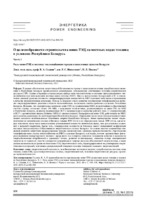| dc.contributor.author | Седнин, В. А. | |
| dc.contributor.author | Игнатович, Р. С. | |
| dc.contributor.author | Иокова, И. Л. | |
| dc.coverage.spatial | Минск | ru |
| dc.date.accessioned | 2023-12-12T06:26:27Z | |
| dc.date.available | 2023-12-12T06:26:27Z | |
| dc.date.issued | 2023 | |
| dc.identifier.citation | Седнин, В. А. Механизм развития транспортно-логистической системы: инфраструктуры электрического транспорта = On the Feasibility of Building Mini-Thermal Power Plant Using Local Fuels in the Conditions of the Republic of Belarus / В. А. Седнин, Р. С. Игнатович, И. Л. Иокова // Наука и техника. – 2023. – № 6. – С. 508-518. | ru |
| dc.identifier.uri | https://rep.bntu.by/handle/data/138364 | |
| dc.description.abstract | В рамках обеспечения энергетической безопасности страны и проведения политики декарбонизации эконо- мики в Республике Беларусь предполагается максимальное использование собственных топливно-энергетических ресурсов (ТЭР). Однако открытым остается вопрос выбора вида теплоисточника в системах централизованного теплоснабжения при использовании местных видов топлива (МВТ). Ввод в эксплуатацию Белорусской АЭС и относительно высокая удельная стоимость электрогенерирующих мощностей на МВТ склоняют чашу весов к применению в качестве теплоисточников котельных. Исходя из мирового опыта развития и применения теплофикации как наибо- лее энергоэффективного решения в области теплоснабжения, исследована данная проблема в условиях Республики Беларусь. Показано, что электрическая мощность мини-ТЭЦ на традиционных МВТ, подключенных к объединенной системе страны, составляет менее 100 МВт, а основными технологиями, реализованными на мини-ТЭЦ на МВТ в Республике Беларусь, являются традиционные ПСУ с водяным паром в качестве рабочего тела (11 электростанций) и ПСУ с органическим циклом Ренкина (ОРЦ) (3 электростанции). Географически мини-ТЭЦ, работающие на МВТ, расположены равномерно по всей территории Республики Беларусь. Определено число часов использования установленной мощности возобновляемых источников энергии Республики Беларусь. Явное преимущество имеют энергоисточники на органических отходах и биомассе (свыше 4000 ч/год) и на гидроресурсах (около 3500 ч/год), для которых показатель числа часов использования установленной мощности значительно выше, чем для установок солнечной и ветровой энергетики. Кроме того, генерирующие мощности на биомассе имеют наименьший коэффициент поставки электроэнергии в Объединенную энергетическую систему Беларуси. На основе анализа современных тенденций развития энергетики сформулированы технико-экономические «факторы привлекательности» строительства теплофикационных систем теплоснабжения на МВТ в условиях Беларуси, к которым, помимо традиционных факторов (замещение импортируемого топлива – природного газа и нефти), относятся повышение качества и надежности энергообеспечения потребителей в удаленных точках, развитие полигенерации, снижение потерь электрической энергии на ее транспорт, участие в покрытии электрического графика нагрузок объединенной энергосистемы, а также указана возможность создания на базе мини-ТЭЦ энергетического хаба, структурированного под интеграцию энергетических подотраслей, источников распределенной генерации и опцию генерации «зеленых» энергоносителей. | ru |
| dc.language.iso | ru | ru |
| dc.publisher | БНТУ | ru |
| dc.title | О целесообразности строительства мини-ТЭЦ на местных видах топлива в условиях Республики Беларусь | ru |
| dc.title.alternative | On the Feasibility of Building Mini-Thermal Power Plant Using Local Fuels in the Conditions of the Republic of Belarus | ru |
| dc.type | Article | ru |
| dc.identifier.doi | 10.21122/2227-1031-2023-22-6-508-518 | |
| local.description.annotation | Within the framework of ensuring the country's energy security and pursuing a policy of decarbonization of the economy in the Republic of Belarus, it is assumed to maximize the use of its own fuel and energy resources (TER). However, the question of choosing the type of heat source in centralized heat supply systems when using local fuels (LF) remains open. The commissioning of the Belarusian Nuclear Power Plant and the relatively high unit cost of power generation capacities running on LF inclines the scales to use boiler houses as heat sources. Based on the world experience in the development and application of heating as the most energy-efficient solution in the field of heat supply, this problem has been studied in the conditions of Belarus. It is shown that the electric capacity of mini-thermal power plants using traditional LF connected to the unified system of the country is less than 100 MW, and the main technologies implemented at mini-thermal power plants using LF in the Republic of Belarus are traditional steam power plants with water steam as the working fluid (11 power plants) and steam power plant with organic Rankine cycle (ORC) (3 power plants). Geographically, mini- thermal power plants operating on LF are located evenly throughout the entire territory of the Republic of Belarus. The number of hours of use of the installed capacity of renewable energy sources (RES) of the Republic of Belarus has been determined. Energy sources based on organic waste and biomass (over 4,000 hours per year) and on hydro resources (about 3,500 hours per year) have a clear advantage, for which indicator of the number of hours of installed capacity use is much higher than for solar and wind power installations. In addition, biomass generating capacities have the lowest coefficient of electricity supply to the combined energy system. Based on the analysis of modern trends in the development of energy, technical and economic “attractiveness factors” for the construction of heating systems for heat supply on LF in the conditions of Belarus have been formulated, which, in addition to traditional factors (substitution of imported fuel – natural gas and oil), include improvement of the quality and reliability of energy supply to consumers in remote locations, development of polygeneration, reduction of losses of electric energy for its transport, participation in covering the electric load schedule of the unified power system, and also indicated the possibility of creating an energy hub on the basis of a mini-thermal power plant, structured for the integration of energy sub-sectors, distributed generation sources and the option of generating “green” energy carriers. | ru |

